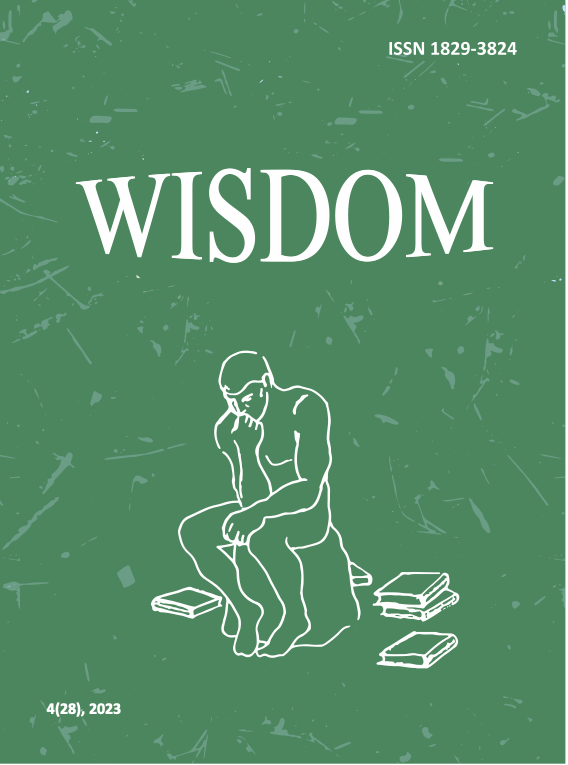Perception Of The Spiritual Symbol In Armenian Medieval Philosophy And Theology
DOI:
https://doi.org/10.24234/wisdom.v13i2.274Keywords:
spiritual symbol, allegory, the Middle Ages, philosophy, Christianity, the BibleAbstract
The article presents the perceptions and viewpoints of the Armenian medieval literary men concerning the spiritual symbol. Being anchored in the pan-Christian perception of the symbol, it laid the basis of the symbolic-allegorical thinking of the Armenian spiritual culture.
In the history of the Armenian medieval literature and art studies, the analysis of symbols, in essence, the discovery of the epiphany in them, which is the fundamental meaning of the culture, have often been neglected.
Today there is a necessity to analyse the spiritual culture in a new way to dig out its ideological – world outlook basis conditioned by the artistic and the festival and ritual functions of the different types of art. Such a research also enables us to comprehend the aesthetic, artistic and doctrinal - philosophical merits of the spiritual culture (literature, miniature, architecture, etc.) created throughout the centuries and still unknown to us in a new way, to review the system of criteria and ideological-methodological basis of the evaluation, which bears a great significance for the complete and precise perception and evaluation of the Armenian art and literature of the Middle Ages.
Downloads
References
Abeghyan, M. (1968). Erker (Selections, in Armenian) (Vol. III). Yerevan: Publishing House of the Armenian SSR.
Alvrtsyan, H. (2017). Hogevor taghi khorhrdabanut’yuny’ (Symbolism of the Spiritual Poem, in Armenian). Antelias Publishing House.
Avernitsev, S. (1977). Poetika rannevizantiiskoi literatury (Poetics of the Early Byzantine Literature, in Russian). Moscow: Nauka Publishers.
Bichkov, V. (1981). Estetika pozdnei antichnosti (Aesthetics of Late Antiquity, in Russian). Moscow: Nauka Publishers.
Confession of Vahram Rabuni. Matenadaran after Mesrop Mashtots, manuscript № 2678.
David the Invincible, (1980). Erkasirut’yunk pilisopayakank (Philosophical Work, in Armenian). Yerevan: Publishing House of the Armenian SSR.
Ghazaryan, V. (Ed.). (2004). Meknut’yunq khoranats, hetazotut’yun & bnagrer (Interpretation of Canontables: Research and Originals). Mother See of Holy Etchmiadzin.
Ghulikyan, T. (2011). Yearbook: Vahram Rabunu Davanabanakan Hajatsqnery’ (The Doctrinal Views of Vahram Rabuni, in Armenian). Yerevan: Zangak 97.
Tatevatsi, G. (2005). Erg Ergotsi Meknut’yun (Commentary of the Song of Songs, in Armenian). Yerevan: Ankyunaqar.
Guryevich, A. (1972). Kategorii srednevekovoi kul’tury (Categories of the Culture of the Middle Ages, in Russia). Moscow: Iskusstvo.
Odznetsi, Hovhannes Imastaser. (1953). Matenagrut’yunk (Bibliography, in Armenian). 2nd ed. Venice: Surb Ghazar.
Khachatryan, P. (1996). Grigor Narekatsin & hay mijnadary (Gregory Narekatsi and the Armenian Middle Ages, in Armenain). Echmiadzin: St. Echmiadzin Publishing House.
Kyoseyan, H. (1995). Drvagner mijnadaryan arvesti astvatsabanutyan (Episodes from the Theology of the Medieval art, in Armenian). Echmiadzin: St. Echmiadzin Publishing House.
Likhachev, D. (1985). Svoeobrazie istoricheskogo puti russkoi literatury X-XVII vv., v sbornike Proshloe-budushchemu, Stat'i i ocherki (The Peculiarity of the Historical Path of the Russian Literature in the X-XVII centuries: In the collection of the Past to the Future: Articles and Essays, in Russian). Leningrad: Nauka Publishers.
Lotman, Yu. (2000). Semiosphera (Semiosphere, in Russian). Saint Petersburg: Iskusstvo.
Narekatsi, G. (1840). Matenagrut’yunk (Bibliography, in Armenian). Venice: Surb Ghazar.
Lambronatsi, N. (2004). Meknut’yun Soghomon imastuni (Commentary of Solomon, in Armenian). Yerevan: Erevani Hamalsarani Hratarakchutyun.
Nerses the Graceful. (1830). Banq chapav (Poetic Speech, in Armenian).Venice: Surb Ghazar.
Tamrazyan, Hr. (2004). Gregor Narekatsin & norplatonakanut’yuny (Gregory Narekatsi and the New Platonism, in Armenian). Yerevan: Nairi.
The Holy Bible. (2014). King James Version. USA: Createspace Independent Publication.
Vetsorya (Six days). Matenadaran after Mesrop Mashtots, manuscript № 2229.
Yeghishe. (1859). Srbo horn mero Yeghishe vardapeti matenagrutyunk (Bibliography by Our Holy Father Yeghishe Archimandrite, in Armenian). Venice: Surb Ghazar.
Zaqaryan, S. (1997). Hay imastasernery (The Armenian Philosophers, in Armenian). Yerevan: Erevani Hamalsarani Hratarakchutyun.
Downloads
Published
How to Cite
Issue
Section
License
Creative Commons Attribution-Non-Commercial (CC BY-NC). CC BY-NC allows users to copy and distribute the article, provided this is not done for commercial purposes. The users may adapt – remix, transform, and build upon the material giving appropriate credit, and providing a link to the license. The full details of the license are available at https://creativecommons.org/licenses/by-nc/4.0/.















